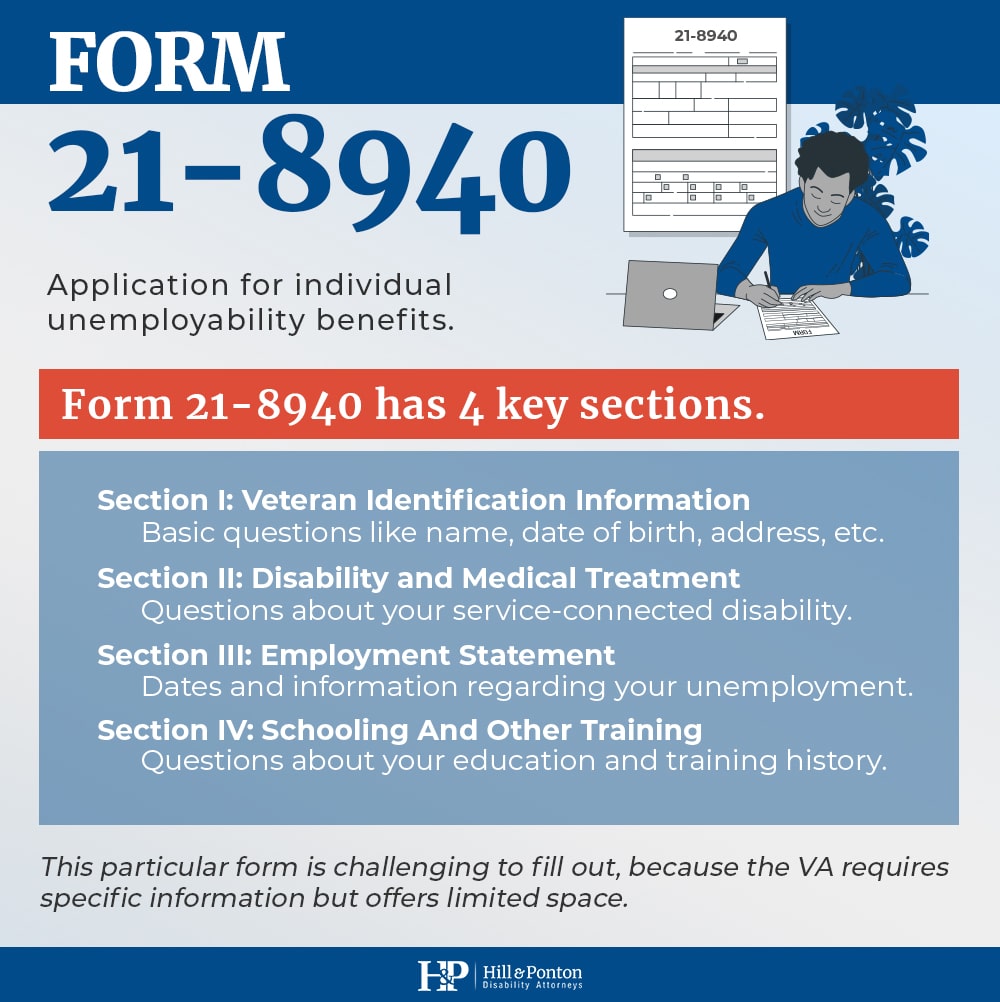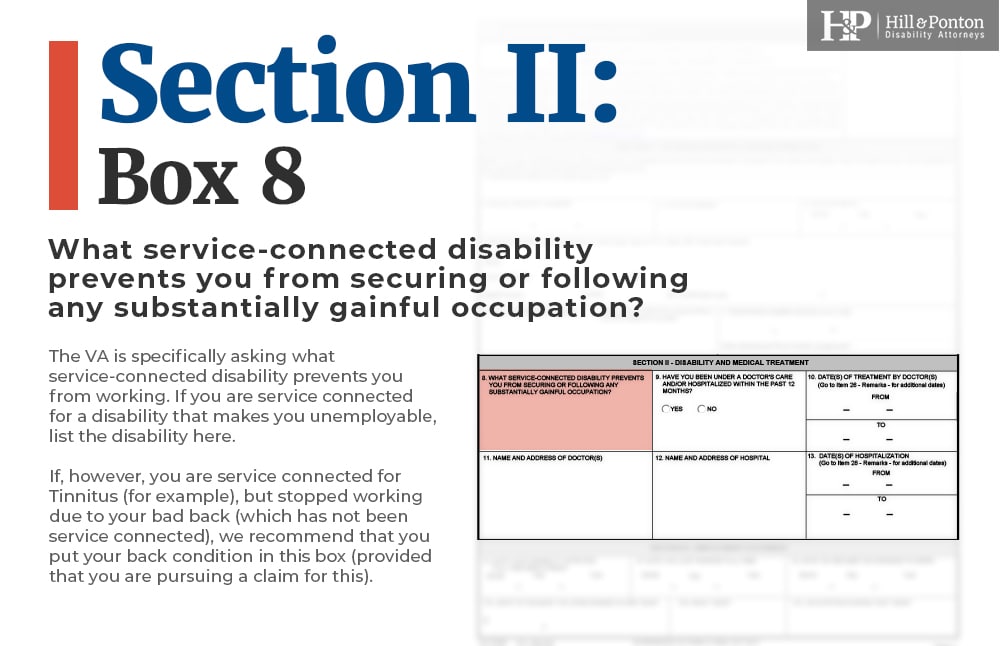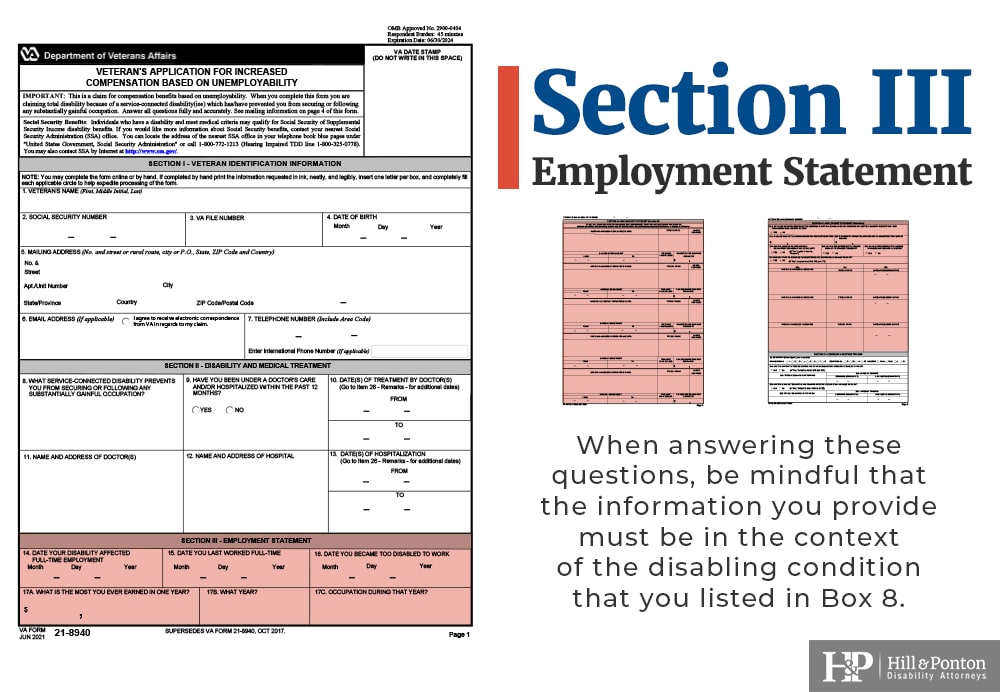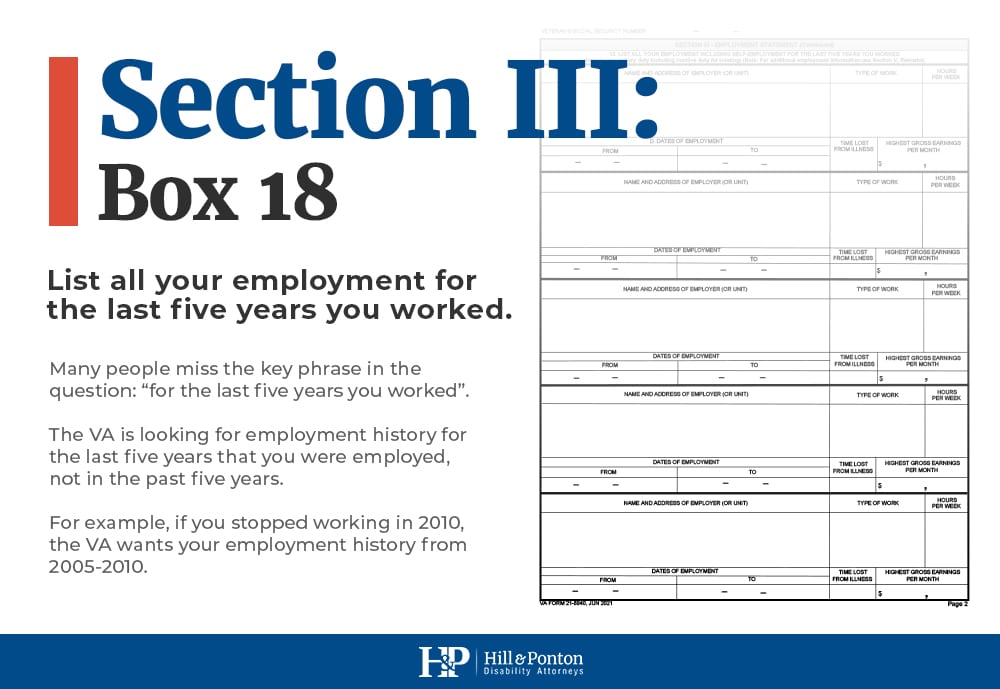Filling out VA Form 21-8940 can be a critical step for veterans seeking Total Disability Individual Unemployability (TDIU) benefits, but the form’s complexity often poses a challenge.
TDIU benefits are designed for veterans whose service-connected disabilities prevent them from maintaining gainful employment, potentially allowing them the same benefits as those with a 100% disability rating.
Our law firm’s expert attorneys have streamlined the process into an easy-to-follow guide, simplifying each step of filling out the form.
This blog post will provide you with a clear pathway through the specifics of VA Form 21-8940, ensuring you present your case for TDIU benefits effectively and efficiently.
Let’s dive in so you can get on your way to getting benefits you deserve!

Section I: Veteran ID Info
This section is the most straightforward. Simply fill out the following information:
- Name
- Social Security Number
- VA File Number
- Date of Birth
- Mailing Address
- Email Address
- Telephone Number
Section II: Disability and Medical Treatment
This section includes Boxes 8-13.
When filing these out the boxes in section II, think in general terms.
Box 8: Identifying Your Service Connected Disability
- Only list the disability or disabilities that are officially recognized (service-connected) by the VA and make it impossible for you to work.
- For example, if you have tinnitus but are unable to work due to a non-service-connected back issue, do not list tinnitus. Instead, if you’re seeking service connection for your back, list your back condition.
- If you have more than one service-connected disability stopping you from working, mention only the two most impactful ones (like a back condition and PTSD).
Box 9: Have You Seen a Doctor or Been Hospitalized in the Last Year?
If you have received care from doctors and from a hospital, then answer “Yes.”
If you are being treated by only one, then list which one.
The next boxes will provide space to give facility/doctor information.
Box 10: Date(s) of Treatment by Doctor(s)
The best way to answer this question is to think in terms of frequency – not exact dates.
How often do you receive treatment? Weekly? Monthly? Every two weeks? Twice a year?
Note: This question refers only to treatment that you are receiving for the condition that you listed in Box 8.

Box 11: Name and Address of Doctor(s)
If you are being treated by a private doctor, list the doctor’s name and address in this box.
- If you are being treated by more than one private doctor, you can include a separate attachment with the names and addresses.
- If you are being treated by VA doctors, then list the doctor’s name and the VA facility you go to.
- Remember: this information only applies the condition that you listed in Box 8
Box 12: Name and Address of Hospital
If you have been or are being treated by a private hospital, list the facility name and address in this box.
- If you are being treated at a VA facility, simply list the facility name, city and state
- Remember: this information only applies the condition that you listed in Box 8
Box 13: Date(s) of Hospitalization
Refer to Box 10
Section III: Employment Statement
This section refers to Boxes 14-22.
Be mindful that the information you provide must be in the context of the disabling condition that you listed in Box 8.
Box 14: Date Your Disability Affected Full-Time Employment
Consider the question like this: When did your condition start affecting your full-time employment OR when did it impact your work performance?
- If you are having trouble with a date, think about this: Was there a time when you started getting written up, missing work for doctor’s visits, calling out sick, getting your shift covered?
- Generally, a month and year is sufficient for this question
Box 15: Date You Last Worked Full-Time
This can be when you transitioned from full to part time, or from gainful employment to not working at all or marginal employment.

Box 16: Date You Became too Disabled to Work
This is the date that you stopped working due to the condition listed in Box 8.
If you cannot remember the exact date, a month and year will suffice.
Box 17A: What is the Most You’ve Ever Earned in One Year?
This is a comprehensive question.
The VA wants to know how much you have ever earned in one year over your lifetime.
If you cannot remember the exact amount, a ball-park figure will suffice.
Box 17B: What Year?
List the year during which you earned the amount that you listed in Box 17A.
Box 17C: Occupation During That Year
List your occupation or job title for which you earned the amount listed in Box 17A.
Box 18: List All Employment for Last Five Years You Worked
While this seems fairly self-explanatory, many people miss the key phrase in the question: “for the last five years you worked.”
The VA is looking for employment history for the last five years that you were employed, not in the past five years.
For example, if you stopped working in 2010, the VA wants your employment history from 2005-2010.
- The VA wants names and addresses of the places/companies that you worked for. If this information is missing, the VA will send you a notice requesting the names and addresses.
- If the company you worked for is no longer in business, fill in the information as best you can, and indicate in Box 18A that the company is out of business.
- If you were self-employed, indicate this in Box 18A, along with the name of your business (if applicable).

Box 18B: Type of Work
Give your job title or type of work.
This could be supervisor, truck driver, salesman, refrigeration repair, etc.
Box 18C: Hours Per Week
If the hours varied, give an average.
You can also use a range (35-40).
Box 18D: Dates of Employment
Use the month and year that you started and left the employer.
Box 18E: Time Lost from Illness
This question references the disabling condition(s) that you listed in Box 8.
As with the first part of the form, think in terms of frequency.
Did you call out monthly or weekly? Did you use all your vacation time? Were you out two weeks a year? Ten hours a week?
Box 18F: Highest Gross Earnings Per Month
The VA wants to know the most amount of money that you made per month at that particular company.
If you cannot remember the exact amount, but do remember what you were being paid hourly, multiply that number by the hours you worked in a week, and calculate your monthly pay that way.
Box 18Q: Indicate Total Earned Income for the Last 12 Months
The key word here is “earned” income.
This is money earned from physically working and receiving payment. This does NOT include: pensions, retirement, IRA’s, 401k’s, SSD or SSI.
Generally, this amount should be $0.
However, if you stopped working within the past 12 months or are working part time, you will need to indicate how much you earned/are earning.
Box 18R: If Presently Employed, Indicate Current Monthly Income
If you are not physically working, this amount should be $0.
However, if you are working, give the amount that you earn per month.
Box 19: Did You Leave Your Last Job/Self-Employment Because of Your Disability?
This question is reflective of the disabling condition(s) that you listed in Box 8.
Check “Yes” if you were fired, laid off, or resigned from your last job because of the disabling condition(s).
Check “No” if you left your last job due to outside circumstances, such as being laid off due to the economy.
Box 20: Do You Receive/Expect to Receive Disability Retirement Benefits?
In addition to Disability Retirement benefits, this also includes any Social Security benefits, such as SSD and SSI.
Box 21: Do You Receive/Expect to Receive Workers Compensation Benefits?
Self-explanatory
Box 22: Have You Tried to Obtain Employment Since You Became too Disable to Work?
This only applies if you have applied to any jobs since you stopped working.
- If you cannot remember, answer “No”
- If you have applied for work, list the name and address of the business/employer, the type of work and the date applied. There are boxes to list three employers in this section.
Section IV: Schooling And Other Training
Box 23: Education
Check the highest level of education that you completed.
The answers include grade school, high school, and college, as well as corresponding grade levels.
Box 24A: Did You Have Any Other Education and Training Before You Were too Disabled to Work?
This applies to any education or training before you stopped working.
This could include trade schools or specialized training, such as truck driving school, welding school, mechanics, etc.
If not, answer “No”, and leave Boxes 24B & 24C blank.
Note: you may have used your GI Bill for this.
Box 25A: Have You Had Any Education and Training Since You Became too Disabled to Work?
This applies to any education or training that you had in an attempt to get a job after you became too disabled to work.
This could include vocational rehab.
If not, answer “No”, and leave Boxes 25B & 25C blank.
Be sure to fill out the dates of training in the corresponding boxes.
Box 26: Remarks
This section is usually left blank. However, you can use this to make additional notes on any of the previous sections.
Congratulations! You’ve gotten through VA Form 21-8940 for TDIU benefits! For extra tips, also check out VA attorney Stacey Clark’s video below.
Attorney Tips on Filing for TDIU
VA procedures can be difficult to navigate, but you don’t have to do it alone. Find all the information you need, for free, in our ebook The Road to VA Compensation Benefits (or its print version).
Get the Free EbookWe hope this guide has been helpful. If you would like to learn more about the TDIU Claim Timeline, please check out our article that will walk you through what to expect next!

The TDIU Claims Timeline Guide – Click Here to Read!
Cassandra Crosby, an Accredited Agent and claims advocate for Matthew Hill & Shelly Mark’s teams, reviewed the information provided in this post.




